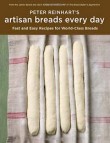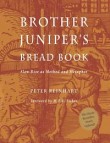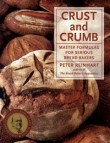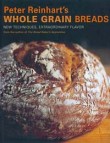Report from Asheville, Part One
I made two doughs in advance of the festival, on Thursday actually, and brought them with me on Saturday to Asheville, which is two hours northwest of Charlotte. Just prior to the demo we baked off some sandwich style loaf breads, and a few hearth style batards, and five pans of raisin and cranberry breakfast focaccia, all made exclusively with the sprouted wheat flour (my helpers included students from the excellent culinary program at A-B Tech, where we held a number of the classes, as well as some of my own students from Johnson & Wales University — they were all great! In fact, it was my students who made the doughs on Thursday).During the class, I showed how to use the flour and Joe Lindley answered questions about it.
Here’s the story on the flour, which was provided by Lindley Mills:
Anyone who has ever had Ezekiel Bread or Alvarado Street Bread knows about sprouted wheat, but this new flour is something different. Those aforementioned breads use wheat berries that have been sprouted and then mashed into a pulp, supplemented with vital wheat gluten, honey, salt, yeast, and water and, voila!, it makes a pretty decent bread without using any “flour” at all because the wheat is never actually ground into flour, only into a pulp. But with the new version of sprouted wheat flour that I used at the festival, on the other hand, it starts with sprouted wheat berries but then the berries are dried, and then the dried sprouts are milled into a very fine flour, and treated as flour from that point on. The amazing thing is how much water this new flour can absorb–typically around 90%-100% of the flour weight (as opposed to a typical 72%-75% for regular whole wheat flour, and only 65%-68% water to flour for white bread). More importantly, the flavor of this sprouted flour is unbelievable–sweet and tender — yet it forms a strong gluten network and is high in protein. I added no oil to tenderize it, no sugar or honey to sweeten it; it was perfect without any of those additions. In my opinion, it makes the best whole wheat bread I’ve ever eaten or made, and I think it definitely represents the next frontier in flour and bread making. The supply is limited right now so it’s not yet available for home bakers, as bakeries like Whole Foods and some other companies are buying all that the three mills who make it can produce (I’m even consulting now with a pizza company that wants to use it for their doughs–this flour makes fabulous pizza crust!). But, as the capacity of the mills increases, you should be able eventually to buy it directly from them or, hopefully, off the grocery store shelves. I will keep you up to date on this as the story unfolds but, when it becomes all the rage, remember that you heard it here first.
I’ll continue this next week, along with other highlights from the festival. Till then, may your bread always rise and may your pizzas all be perfect!
Recent Articles by Peter Reinhart
- Howard Brownstein on Turnaround and Crisis Management
- Randy Clemens and Forest Farming in Uruguay — The Back to The Earth Movement is Back!
- It’s not too late to chase your dreams: “Pizza From the Heart” A New Book by Paulie and Mary Ann Gee
- Kyle Ahlgren on the Artisan Baking Center Online Classes (and a special offer)
- Multi-James Beard Nominee Cathy Whims of Portland’s Nostrana and her Brand New Book
- Pizza Quest: KID, Manhattan’s New Slice Cafe, with Chefs Ian Coogan and Max Blackman-Gentile
Add Comment
You must be logged in to post a comment.










Very interesting Peter!
Can this method for sprouted wheat flour be done at home if you have your own grain mill and some wheat berries? If so, can you post the method?
Adding a second to that request. I’ve done a lovely sprouted wheat flatbread from crushed berries, and would love to try working with the sprouts and my grain mill, without reinventing the wheel or imperiling my 25+ year old impact mill.
So….any suggestions as to how long the sprouts are before the sprouted berries are dried, and how they’re dried (lower than the home oven minimum temp of 175 degrees would be very hard for me to achieve consistently).
I don’t know the actual technique that Lindley Mills and the other two mills use (Essential and To Your Health who, I think, sell it via mail order if you go to their website), but what I’d do is soak the wheat berries overnight, drain them and wait for them to show a nub of a sprout. Then, use a food dehydrator to dry them, and then mill them to a fine flour. If you don’t have a dehydrator, put them on a screen in front of a fan and dry them that way–it will take longer but should work within a day or two. Let us know how it goes and, if you get a good product, I’ll send you a recipe to make bread or focaccia with it. Write to me at peter@pizzaquest.com
Just discovered the convection/microwave has a 100 degree setting.
Soaking some hard white wheat berries now!
Thanks Peter. How long do you think it will take in the dehydrator? Is there a good method to check if the berries are dry?
Diane – where do you get your hard white winter from?